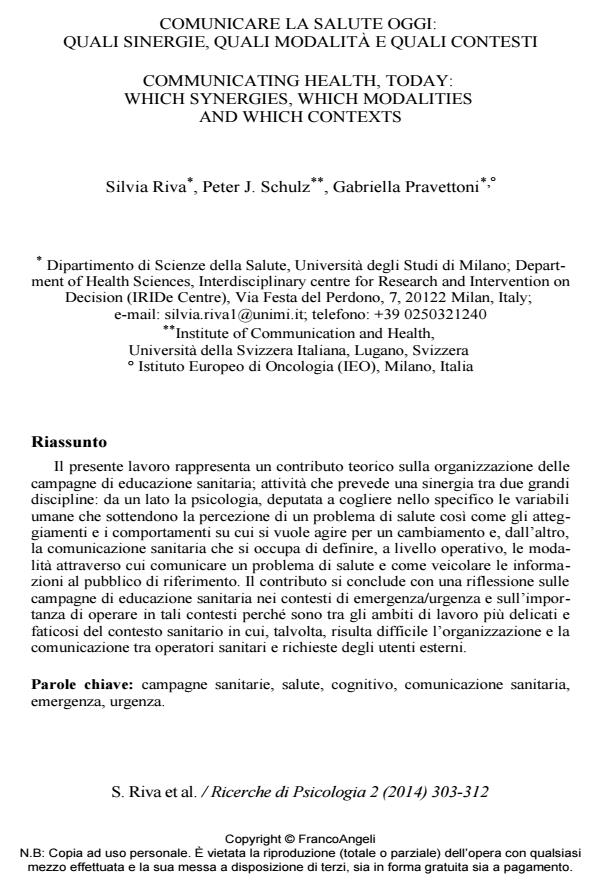Communicating health, today: which synergies, which modalities and which contexts
Journal title RICERCHE DI PSICOLOGIA
Author/s Silvia Riva, Peter J. Schulz, Gabriella Pravettoni
Publishing Year 2015 Issue 2014/2 Language Italian
Pages 10 P. 303-312 File size 162 KB
DOI 10.3280/RIP2014-002006
DOI is like a bar code for intellectual property: to have more infomation
click here
Below, you can see the article first page
If you want to buy this article in PDF format, you can do it, following the instructions to buy download credits

FrancoAngeli is member of Publishers International Linking Association, Inc (PILA), a not-for-profit association which run the CrossRef service enabling links to and from online scholarly content.
The current work represents a theoretical contribution on health campaign’s organization; this activity needs the synergy between two important disciplines: Psychology, from one side, aimed to study both human variables linked to health problems’ perception and attitude and behaviours we want to change, and Health Communication, from the other side, aimed to study operations and modalities to communicate health problems as well as how to diffuse information to health campaign’s public. This contribution concludes with a consideration about health campaign in the context of emergency/urgency; this context is very important for health campaign but it is extremely hard and it sometimes has to face challenging events or a difficult communication between health professionals and patients.
Keywords: Health campaign, health, cognitive, health communication, emergency, urgency.
- Albada, A., Ausems, M., Bensing, J., & van Dulmen, S. (2009). Tailored information about cancer risk and screening: A systematic review. Patient Education and Counselling, 77, 155-171. DOI: 10.1016/j.pec.2009.03.005
- Arnaudo, M. (2013). Il fumetto supereroico. Mito, etica e strategie narrative, Roma: Tunue Lapilli.
- Camerini, L., Schulz, P.J., & Rubinelli, S. (2010). Comunicazione e Salute. Bologna: Apogeo Editore. Di Clemente, R.J., Crosby, R.A., & Kegler, M.C. (Eds.) (2002). Emerging Theories in Health Promotion Practice and Research. San Francisco: Jossey-Bass Ed.
- Eugenti, R. (2010) Semiotica dei media. Le forme dell’esperienza. Firenze: Carocci.
- Fiorentini, G., Lippi Bruni, M., Mammi, I., & Ugolini, C. (2013). Valutazione dell’impatto prodotto nelle regioni monitorate per la riduzione degli accessi impropri in pronto soccorso. Quaderni di Monitor, 32, 87-108.
- Glanz, K., & Rimer, B.K. (2005). Theory at a Glance: A Guide to Health Promotion Practice. Bethesda: National Cancer Institute.
- Glanz, K., & Bishop, D. (2010). The role of behavioral science theory in development and implementation of public health interventions. Annual Review of Public Health 31, 399-418. DOI: 10.1146/annurev.publhealth.012809.103604
- Glanz, K., Rimer, B.K., & Viswanath, K. (Eds.) (2008). Health Behavior and Health Education: Theory, Research, and Practice (4th ed). San Francisco: Jossey-Bass Ed.
- Grol, R.P., Bosch, M.C., Hulscher, M.E., Eccles, M.P., & Wensing, M. ( 2007). Planning and studying improvement in patient care: the use of theoretical perspectives. Milbank Quarterly, 85, 93-138. DOI: 10.1111/j.1468-0009.2007.00478.x
- Hovland, C., Janis, I., Kelley, H.H. (1953). Communication and Persuasion. New Haven: Yale University Press.
- Lustria, M.L., Cortese, J., Noar, S.M., & Glueckauf, R.L. (2009). Computer-tailored health interventions delivered over the web: review and analysis of key components. Patient Education and Counselling, 74, 156-73.
- McLeroy, K.R., Bibeau, D., Steckler, A., & Glanz, K. (1988). An ecological perspective on health promotion programs. Health Education Quarterly, 15, 351-377.
- Ministero della salute (2009). Modalità organizzative per garantire l’assistenza sanitaria in h 24: riduzione degli accessi impropri nelle strutture di emergenza e miglioramento della rete assistenziale territoriale.
- Noar, S.M., Chabot, M., & Zimmerman, R.S. (2008). Applying health behavior theory to multiple behavior change: considerations and approaches. Preventive Medicine, 46, 275-280. DOI: 10.1016/j.ypmed.2007.08.001
- Panuccio, A. (2013). Sistema di emergenza-urgenza:appropriatezza nell’utilizzo dei servizi di primo contatto, Quaderni di Monitor, 32, 24-27.
- Rice, E.R., & Atkin, C.K. (2001). Public communication campaigns. Thousand Oaks: SAGE.
- Smedley, B.D., & Syme, S.L. (Eds.) (2000). Promotion Health: Intervention Strategies from Social and Behavioral Research. Washington DC: National Academy Press.
- Vannoni, D. (2001). Manuale di Psicologia della Comunicazione Persuasiva. Torino: Utet.
- Corruption in Public Procurement Auctions: Positive Equilibrium Analysis, Incentive Mechanism Design, and Empirical Study Maria Monica Wihardja, in SSRN Electronic Journal /2009
DOI: 10.2139/ssrn.1294088
Silvia Riva, Peter J. Schulz, Gabriella Pravettoni, Comunicare la salute oggi: quali sinergie, quali modalita e quali contesti in "RICERCHE DI PSICOLOGIA " 2/2014, pp 303-312, DOI: 10.3280/RIP2014-002006